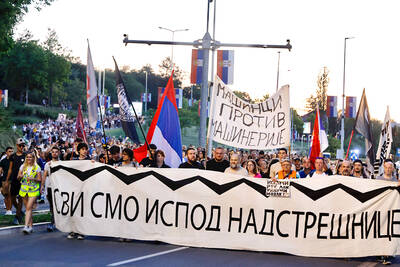Russian authorities were reportedly warned that Siberia’s massive Sayano-Shushenskaya hydroelectric power plant had fallen into serious neglect and was unsafe in 1998, more than a decade before this week’s deadly accident.
The death toll rose to 64 yesterday as rescuers continued draining the turbine room and recovered 17 more bodies. Eleven workers were still missing from Monday’s accident, which has highlighted the dangers of Russia’s creaking infrastructure.
For years, the Kremlin was urged by independent experts and even its own ministries to invest some of its oil-and-gas billions to update Soviet-era infrastructure.
A lack of expertise, however, combined with government apathy, means that not only Russian power plants, but also dangerous roads, decaying utilities, aging transport fleets and creaking buildings continue to take victims as they fall further into disrepair.
Russian Prime Minister Vladimir Putin, who toured the crippled Siberian power plant on Friday, has acknowledged that Russia must plan for the regular upgrade of “vital parts of infrastructure.”
But Vladimir Tikhomirov, chief economist at the Moscow-based bank UralSib, said Russia had to spend big if it wanted to reverse the neglect of the stagnant 1990s.
“It’s about more than US$100 [billion] to US$200 billion if we’re talking about all infrastructure — and you can’t make it all in one year,” he said on Friday.
The latest statistics show that as little as 7.4 percent of all equipment in the power sector was replaced by 2007. Studies showed that half needed replacing and 15 percent was worn out beyond repair.
Russian Energy Minister Sergei Shmatko has said it would cost 40 billion rubles (US$1.2 billion) just to rebuild the damaged turbine room.
Putin on Friday urged the state-owned plant operator RusHydro to compensate the families of the dead at Sayano-Shushenskaya. RusHydro has already pledged to pay 1 million rubles to the families. Putin promised to match the company’s payouts with federal money.
The Emergency Situations Ministry — whose 1,000-strong search team kept up the search for those feared dead — warned back in 1998 that the dam had fallen into dangerous neglect, a report by the business daily Kommersant said.
The same ministry forecast in 2005 that decaying infrastructure would be the cause of most technological accidents in the coming years, saying more than 60 percent of Russia’s water pipes, sewage, heating and electricity networks needed urgent replacement.
Even Putin accepted in December that 80 percent of Russia’s heating network needed repairs — a critical issue for a nation with such severe winter weather.
Most signs of poor maintenance, however, fail to engage local Russian officials.
Ordinary Russians have endured thousands of low-profile gas explosions in homes, road accidents involving 30-year-old buses and frequent electricity blackouts.
Gas blasts in particular highlight the nation’s infrastructure problem. Many Russians in residential buildings that aren’t rigged for cooking gas use old, high-pressure canisters. Those frequently burst, killing anyone nearby and sometimes leveling buildings. The damage is compounded by buildings that are not structurally sound and overall poor fire-safety standards.
Short-circuits account for a significant number of fires, emergency officials say.
The global economic downturn has thwarted efforts to finance infrastructure upgrades, such as a now-postponed liberalization in energy sector prices that was supposed to allow privatized power plants to generate enough cash to pay for maintenance and new equipment.
Fearing popular discontent, Russian officials have kept energy costs low — but they might have to shift that strategy.
“The federal budget is not going to have the money to adequately invest in those companies’ operations program, so the cost will have to be passed on to the consumers — individuals or companies,” Tikhomirov said. “There’s no other way, otherwise we’ll be in for other technology-caused disasters.”

Eleven people, including a former minister, were arrested in Serbia on Friday over a train station disaster in which 16 people died. The concrete canopy of the newly renovated station in the northern city of Novi Sad collapsed on Nov. 1, 2024 in a disaster widely blamed on corruption and poor oversight. It sparked a wave of student-led protests and led to the resignation of then-Serbian prime minister Milos Vucevic and the fall of his government. The public prosecutor’s office in Novi Sad opened an investigation into the accident and deaths. In February, the public prosecutor’s office for organized crime opened another probe into

RISING RACISM: A Japanese group called on China to assure safety in the country, while the Chinese embassy in Tokyo urged action against a ‘surge in xenophobia’ A Japanese woman living in China was attacked and injured by a man in a subway station in Suzhou, China, Japanese media said, hours after two Chinese men were seriously injured in violence in Tokyo. The attacks on Thursday raised concern about xenophobic sentiment in China and Japan that have been blamed for assaults in both countries. It was the third attack involving Japanese living in China since last year. In the two previous cases in China, Chinese authorities have insisted they were isolated incidents. Japanese broadcaster NHK did not identify the woman injured in Suzhou by name, but, citing the Japanese

RESTRUCTURE: Myanmar’s military has ended emergency rule and announced plans for elections in December, but critics said the move aims to entrench junta control Myanmar’s military government announced on Thursday that it was ending the state of emergency declared after it seized power in 2021 and would restructure administrative bodies to prepare for the new election at the end of the year. However, the polls planned for an unspecified date in December face serious obstacles, including a civil war raging over most of the country and pledges by opponents of the military rule to derail the election because they believe it can be neither free nor fair. Under the restructuring, Myanmar’s junta chief Min Aung Hlaing is giving up two posts, but would stay at the

YELLOW SHIRTS: Many protesters were associated with pro-royalist groups that had previously supported the ouster of Paetongtarn’s father, Thaksin, in 2006 Protesters rallied on Saturday in the Thai capital to demand the resignation of court-suspended Thai Prime Minister Paetongtarn Shinawatra and in support of the armed forces following a violent border dispute with Cambodia that killed more than three dozen people and displaced more than 260,000. Gathered at Bangkok’s Victory Monument despite soaring temperatures, many sang patriotic songs and listened to speeches denouncing Paetongtarn and her father, former Thai prime minister Thaksin Shinawatra, and voiced their backing of the country’s army, which has always retained substantial power in the Southeast Asian country. Police said there were about 2,000 protesters by mid-afternoon, although